Related Research Articles
Tomás Díaz Mendoza is a Mexican professional wrestler, better known by his ring name Villano IV. Within the stable Los Villanos, he has wrestled for Universal Wrestling Association (UWA), AAA, and World Championship Wrestling (WCW). While popular and successful in Mexico, he frequently performed as a jobber in WCW. The other sons of Ray Mendoza who have used the name "Villano" include Villano I, Villano II, Villano III, and Villano V.
Antonio Gómez Medina is a Mexican professional wrestler, or Luchador as they are called in Spanish, and professional wrestling trainer based out of Arena Coliseo Guadalajara in Guadalajara. Gómez is best known under the ring name Máscara Mágica; he is the second person to use the "Máscara Mágica" name, taking it over after Eddie Guerrero abandoned the name in the early 1990s. As Máscara Mágica, he was part of the Los Nuevo Infernales group; as part of a Los Nuevo Inferales vs. Los Infernales storyline, and lost his mask as a result of a Luchas de Apuestas match loss to Los Infernales leader El Satánico. In recent years Gómez has focused more on his training position at Arena Coliseo Guadalajara, where he also works as a booker and part-time wrestler.
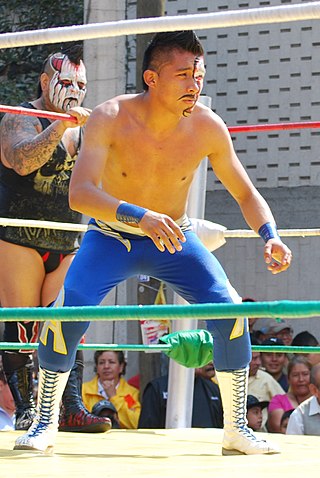
Abraham Arrieta González is a Mexican luchador, or professional wrestler currently working for the Mexican professional wrestling promotion Consejo Mundial de Lucha Libre (CMLL) working under the ring name Mercurio, where he is the current CMLL World Mini-Estrella Champion, in his first reign. As Mercurio González works in CMLL's Mini-Estrella division, which does not necessarily mean that Mercurio is a dwarf as several wrestlers who are just shorter in stature work in the "Mini" division. Mercurio's real name was not a matter of public record while masked, as is often the case with masked wrestlers in Mexico where their private lives are kept a secret from the wrestling fans.
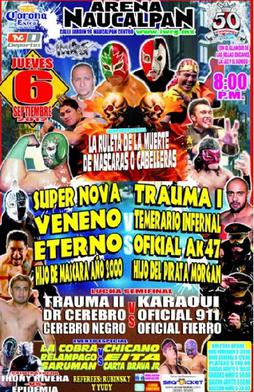
Ruleta de la Muerte (2012) was an annual professional wrestling major event produced and scripted by the Mexican professional wrestling promotion International Wrestling Revolution Group (IWRG), which took place on September 6, 2012 in Arena Naucalpan, Naucalpan, State of Mexico, Mexico. The focal point of the event was the eponymous Ruleta de la Muerte eight-man tournament where all participants put their wrestling mask or hair on the line. The Ruleta de la Muerte tournament is a Lucha libre stable, a tournament which unlike traditional tournaments it is the loser that advances in the tournament, advancing to the final that is contested under Luchas de Apuestas or bet rules.
Espanto Jr. is the most recognizable ring name of Jesús Andrade Salas, a retired Mexican luchador, or professional wrestler. Over his 25-year-long career, Andrade worked under a number of different aliases, most importantly as Espanto Jr., later on as El Santo Negro, and as the first person to work as Pentagón. Andrade was forced to retire from wrestling after suffering a life-threatening injury during a match that briefly left him clinically dead before being revived in the middle of the ring.
Espanto Jr. is a Mexican luchador enmascarado, or masked professional wrestler currently working for the Mexican professional wrestling promotion Consejo Mundial de Lucha Libre (CMLL) portraying a rudo wrestling character, and is a former CMLL Arena Coliseo Tag Team Champion. Espanto Jr.'s real name is not a matter of public record, as is often the case with masked wrestlers in Mexico where their private lives are kept a secret from the wrestling fans. He made his professional wrestling debut in 2001 at the age of only 15.
Los Arlequíns was a Mexican professional wrestling group, called a stable, who worked as a rudo faction. All members of the group started out as masked wrestlers, but several members lost their masks before the group was disbanded.
Arturo Muñoz Sánchez is a Mexican luchador, or professional wrestler who is best known for his time performing Mexican professional wrestling promotion Consejo Mundial de Lucha Libre (CMLL), portraying a rudo wrestling character La Bestia del Ring. He is the father of wrestlers William Arturo Muñoz González and masked wrestlers Dralístico and Dragon Lee, and often teams up with one or more of his sons.
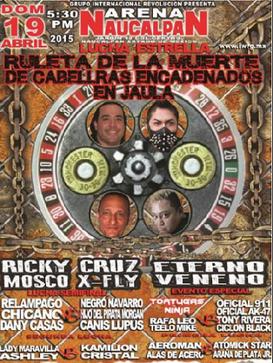
Ruleta de la Muerte was an annual professional wrestling major event produced and scripted by the Mexican professional wrestling promotion International Wrestling Revolution Group (IWRG), which took place on May 5, 2015 in Arena Naucalpan, Naucalpan, State of Mexico, Mexico. The event was named after the Maine vent match, the Ruleta de la Muerte, a steel cage match where all four of the competitors were chained together. The last man in the cage would be forced to have his hair shaved off as a result. The four competitors risking their hair in the match were Ricky Cruz, Eterno, Veneno and X-Fly. The show featured four additional matches.

Los Espantos, sometimes referred to as Los Hermanos Espanto, was a Mexican professional wrestling group, called a stable. The original Espantos team consisted of Espanto I and Espanto II, but later expanded to a trio when Espanto III, the younger brother of Espanto I, joined the group. They primarily worked as a rudo faction for Empresa Mexicana de Lucha Libre (EMLL) and on the Mexican independent circuit. As a team Espanto I and II held the Mexican National Tag Team Championship and Espanto II and III held the Northern Mexico Tag Team Championship. The team of Espanto I and Espanto II are considered among the best rudo teams in the history of lucha libre.
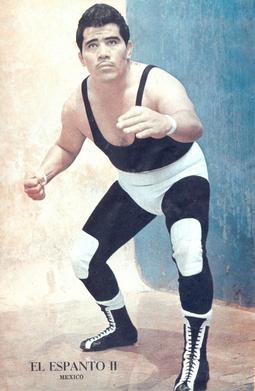
Fernando Cisneros Carrillo, was a Mexican luchador or professional wrestler known under the ring name Espanto II. For most of his career he was closely associated with his tag team partner and close friend José Vázquez, better known as Espanto I as well as Miguel Vázquez known as Espanto III, with the three collectively known as Los Espantos
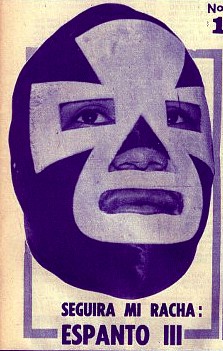
Miguel "Miguelito" Vázquez Bernal, was a Mexican luchador or professional wrestler known under the ring name Espanto III. During his career in lucha libre he formed a long running, successful trio known as Los Espantos with his brother José Eusebio Vázquez Bernal and Fernando Cisneros Carrillo.
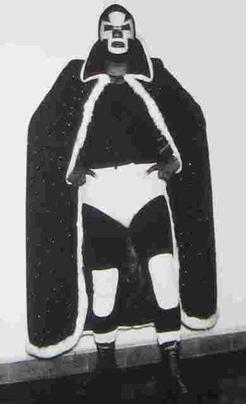
José Eusebio Vázquez Bernal, was a Mexican luchador, or professional wrestler from the mid-1950s until his death in 1968, best known under the ring name Espanto I, part of Los Espantos alongside his lifelong friend Fernando Cisneros Carrillo and his younger brother Miguel Vázquez Bernal. As Los Espantos the three became one of the first "Identical teams" in Mexico.
The Arena Naucalpan 21st Anniversary Show was a major annual professional wrestling event produced and scripted by the Mexican professional wrestling promotion International Wrestling Revolution Group (IWRG), which took place on December 20, 1998 in Arena Naucalpan, Naucalpan, State of Mexico, Mexico. As the name implies the show celebrated the 21st Anniversary of the construction of Arena Naucalpan, IWRG's main venue in 1977. The show is IWRG's longest-running show, predating IWRG being founded in 1996 and is the fourth oldest, still held annual show in professional wrestling.
The Arena Naucalpan 29th Anniversary Show was a major annual professional wrestling event produced and scripted by the Mexican professional wrestling promotion International Wrestling Revolution Group (IWRG), which took place on December 21, 2006, in Arena Naucalpan, Naucalpan, State of Mexico, Mexico. As the name implies the show celebrated the 29th Anniversary of the construction of Arena Naucalpan, IWRG's main venue in 1977. The show is IWRG's longest-running show, predating IWRG being founded in 1996 and is the fourth oldest, still held, annual show in professional wrestling.
The 2000 El Castillo del Terror was a major lucha libre event produced and scripted by the Mexican International Wrestling Revolution Group (IWRG) professional wrestling promotion on November 2, 2000. The 2000 El Castillo del Terror was the first ever IWRG El Castillo del Terror event held, starting an annual tradition for the promotion. The main event was the eponymous Castillo del Terror steel cage match where the last person eliminated would be forcibly unmasked or have his hair shaved off as a result.
In Lucha libre, the Mexican version of professional wrestling, the Ruleta de la Muerte is a type of professional wrestling tournament where the loser or losers of a match would advance in the tournament instead of the winners. The finals of a Ruleta de la Muerte tournament featured the losing teams wrestle each other under Lucha de Apuestas, or "bet match" rules, where the loser would be forced to either unmask or have all their hair shaved off as a result. Various Mexican promotions have held Ruleta de la Muerte tournaments; some like International Wrestling Revolution Group have held these tournaments on a regular basis.
The Mexican professional wrestling promotion International Wrestling Revolution Group produced and scripted a Ruleta de la Muerte tournament on November 5, 2009. The show took place in Arena Naucalpan, in Naucalpan, State of Mexico, Mexico, IWRG's main venue and the site of the majority of all their major shows and tournaments.
The Mexican professional wrestling promotion International Wrestling Revolution Group produced and scripted a Ruleta de la Muerte tournament on October 27, 2013. The show took place in Arena Naucalpan, in Naucalpan, State of Mexico, Mexico, IWRG's main venue and the site of the majority of all their major shows and tournaments.

The Mexican professional wrestling promotion International Wrestling Revolution Group produced and scripted a La Ruleta de la Muerte Máscaras tournament on December 22, 2018. The show took place in Arena Naucalpan, in Naucalpan, State of Mexico, Mexico, IWRG's main venue and the site of the majority of all their major shows and tournaments, and also served as the celebration of the 42nd anniversary of Arena Naucalpan.
References
- 1 2 "Grandes Figuras de la Lucha Libre". Espanto I (in Spanish). Portales, Mexico. November 2008. p. 23. 17.
- ↑ "1988 Especial!". Box y Lucha Magazine (in Spanish). January 10, 1989. pp. 2–28. issue 1864.
- 1 2 3 4 5 6 7 8 9 10 11 12 13 Encyclopedia staff (July 2007). "Enciclopedia de las Mascaras". Espanto IV y V (in Spanish). Mexico. p. 29. Tomo II.
- ↑ Madigan, Dan (2007). "A family affair". Mondo Lucha Libre: the bizarre & honorable world of wild Mexican wrestling. HarperCollins Publisher. pp. 128–132. ISBN 978-0-06-085583-3.
- ↑ "1989 Especial!". Box y Lucha Magazine (in Spanish). January 7, 1990. pp. 2–28. issue 1917.
- 1 2 "Tecnicos – Stuka, Jr". Fuego En El Ring (in Spanish). Retrieved October 20, 2009.
- ↑ Madigan, Dan (2007). "Okay... what is Lucha Libre?". Mondo Lucha Libre: the bizarre & honorable world of wild Mexican wrestling. HarperCollins Publishers. pp. 29–40. ISBN 978-0-06-085583-3.
- ↑ "1999 Especial!". Box y Lucha Magazine (in Spanish). January 10, 2000. pp. 2–28. issue 2436.
- ↑ "2001 Especial!". Box y Lucha Magazine (in Spanish). January 13, 2002. pp. 2–28. Issue 2540.
- ↑ "Lo Mejor de la Lucha Libre Mexicana duranted el 2006". Súper Luchas (in Spanish). December 23, 2006. Issue 192. Retrieved July 11, 2009.
- ↑ "Número Especial - Lo mejor de la lucha libre mexicana durante el 2010". Súper Luchas (in Spanish). January 12, 2011. 399.